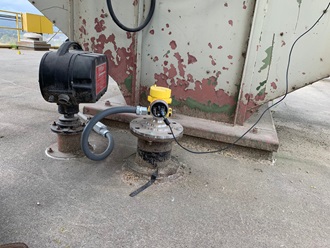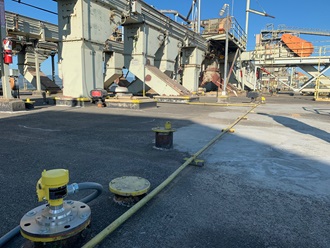More reliable grain level measurements with 80 GHz radar transmitters |
The Port of Portland, located in the state of Oregon, is the number one port in the United States for wheat exports. Roughly 350,000 tons of wheat and other grains move through a single export facility every month.
Towering concrete silos approximately 12 stories tall, as well as smaller tanks and vessels, store all this grain before it’s shipped in bulk cargo containers on large cargo ships. Managing this kind of volume requires accurate, reliable level measurement data to keep the grains moving and the operation running smoothly.
With more than 90 silos, tanks, and level measurement data points, finding the right sensor for every application proved to be a challenge. Fortunately, facility operators were able to work directly with VEGA to test a VEGAPULS 69 non-contact radar level measurement sensor with 80 GHz technology.
Maintaining mechanical level measurement sensors adds up
The VEGAPULS 69 non-contact radar level sensor for solids is easy to wire and program for bulk solids measurements.
This grain export facility in the Pacific Northwest had been using mechanical plumb bob, or yo-yo, level sensors, which drop a weight attached to a cable down to the product surface, then reel it back in. The sensor electronics track the time it takes to complete this and calculates a level measurement.
This sensor’s method of operation works well in theory, but over time, measurement accuracy and reliability begin to deteriorate. As the mechanical parts within the sensor experience wear and tear, it can change the timing of the cable reeling and unreeling, which can affect the accuracy of the measurement. At this export facility, the sensor cable regularly became tangled when it made contact with the product it was supposed to be measuring, resulting in a sensor failure.
At the export grain facility, it had become routine for maintenance employees to check each sensor individually and hit the cable to knock any dust or buildup from it. These scheduled maintenance breaks not only put employees at additional risk as they climbed to the top of the silos so often, but it was also costing an additional estimated $50,000 every year.
Despite their shortcomings, the plumb bob sensors were the best level measurement technology operators had found at the time. But with costs adding up and trust in the sensors dwindling, it was time to upgrade their level measurement technology. At about the same time, VEGA called the facility to learn more about their process.
Non-contact radar level measurements with 80 GHz technology
Multiple bright yellow 80 GHz VEGAPULS 69 radar sensors sit atop the silos. Flange process connections make for an easy installation.
Some of the most difficult level measurements at the grain exporter were massive concrete silos with great distances to measure. To add to the difficulty, dust was common, especially during filling and emptying. Plus, grains like wheat, soybeans, and corn can be abrasive, placing additional wear and tear on any contact measurement sensors.
To overcome all these challenges, VEGA suggested the VEGAPULS 69, a non-contact radar sensor specifically designed and built for bulk solids level measurement. Like other modern radar sensors, it uses a transmission frequency of 80 GHz – a big leap forward from its 26 GHz predecessors. With a higher transmission frequency, modern radar sensors have a more focused beam angle, which provides a stronger return signal for a more reliable and accurate measurement.
The VEGAPULS 69 has a measurement range of up to 393 feet (120 meters), easily capable of measuring the entire span of the largest silos at the site. The radio microwaves used to achieve a measurement essentially “see through” any dust in the air, internal sensor software ignores any product that may build up on the face of the antenna, and the electronic sensor has no mechanical parts, which nearly eliminates any upkeep or maintenance.
The technical specifications of the VEGAPULS 69 easily exceeded every requirement for each level measurement application at the export grain facility, and because the 80 GHz radar has a proven track record of success at other grain plants, operators chose to upgrade the nearly 100 level measurements in their facility.
As each new radar sensor was installed, the Portland grain export facility began to experience the benefits of 80 GHz radar technology. With every radar up and running, they continue to discover ways these small sensors have helped their process.
Maintenance and upkeep costs dropped significantly after every radar was installed and programmed. Personnel didn’t need to regularly inspect or clean the new sensors. The VEGAPULS 69 sensors easily connected to their existing inventory system, so operators are receiving real-time inventory levels without the regular errors or failures they received with the previous technology.
We need your consentThis content is provided by an external provider. If you activate the content, personal data may be processed and cookies set.
Researching level measurement solutions
The Portland grain export facility’s success depends on running their operation efficiently and smoothly. Operators need to know what inventory they have at any given time, and that begins with accurate level measurements. When it was time to upgrade their instrumentation, they put in the work to find the best solution for them.
Finding the right level measurement sensor can be a challenging process. It’s easy to get overwhelmed by the different level measurement technologies, the instrumentation manufacturers, and the specific needs of every application. A local level measurement expert is an invaluable resource, and consulting with one can make the process easier and less time-consuming.
By working with the level measurement experts at VEGA, operators learned about non-contact level measurements with 80 GHz radar technology. The VEGAPULS 69’s versatility, accuracy, and reliability allowed the company to take a one-size-fits-all approach. Now, grains are moving in and out of the Port of Portland more seamlessly than ever.
Related products
Export this article
Download as PDFShare this article
Comments ({{comments.length}})
{{getCommentAuthor(comment, "Anonymous")}} {{comment.timestamp | date : "dd.MM.yyyy HH:mm" }}
{{comment.comment}}







